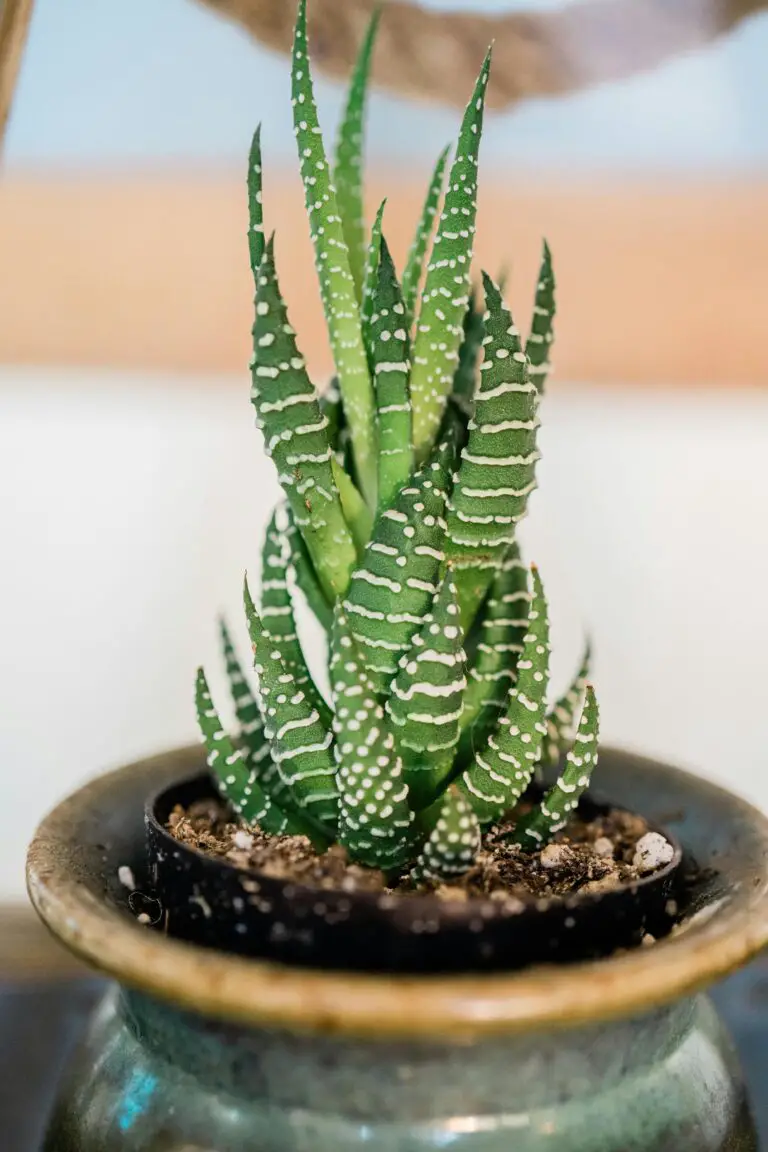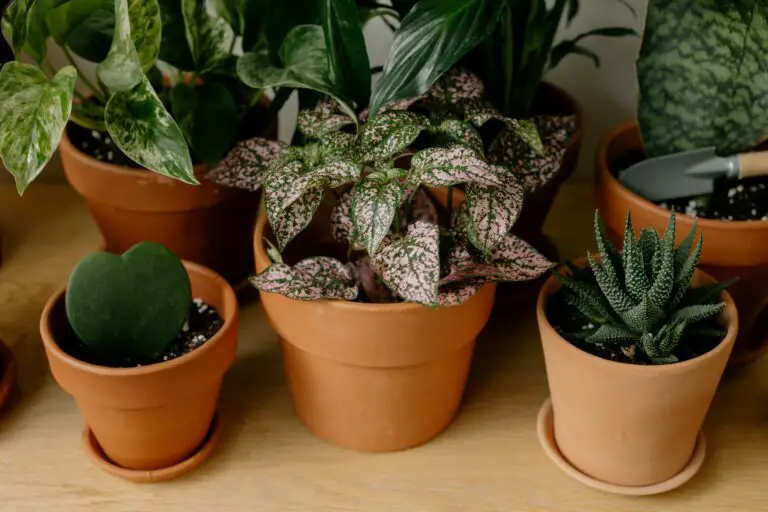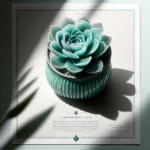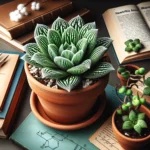Introduction to Haworthia Bayeri: A Remarkable Succulent
Allow me to introduce you to Haworthia bayeri, a gem among succulents that captures the hearts of plant enthusiasts worldwide. Hailing from the rugged landscapes of South Africa, this little botanical wonder has adapted to thrive in the most unforgiving environments. Think of it as capturing the essence of resilience and beauty in a pint-sized package!
Now, picture this: rosettes of lush, juicy leaves, each adorned with pearly bands that catch the light like diamonds on dark velvet. That’s Haworthia bayeri for you – a visual treat with its own unique twist on nature’s designs. Its popularity? Oh, it’s skyrocketing faster than a rocket to Mars! Whether it’s perched on an office desk or basking in the sun on a windowsill, this succulent knows how to make a statement without saying a word.

Curious plant parents might wonder what’s the secret behind their thriving Haworthia bayeri’s lush growth. And if you’re itching to get your hands dirty with these beauties, be sure to explore our in-depth guide on nurturing succulents to their full potential. You’d be surprised at how these low-maintenance marvels can bring a touch of the wild into your urban jungle.
As we dive deeper into this article, get ready to uncover the cultivation and care secrets that unlock the full potential of Haworthia bayeri, ensuring it becomes not just a plant in your collection, but a living sculpture that epitomizes nature’s artistry.
The Optimal Habitat for Growing Haworthia Bayeri
For succulent enthusiasts aiming to cultivate a slice of arid spectacle, Haworthia bayeri is a gem worth deciphering. This exotic succulent hails from the Eastern Cape Province in South Africa, where it basks in the shadows of rocky outcrops, thriving in the microclimate provided by its native quartz fields. The secret to emulating this natural masterpiece? A clever blend of sunlight moderation, impeccable drainage, and that air of mystery only semi-shade can proffer.
At home, reconnoitering a Haworthia-friendly locale may hint at an indoor east-facing sill or a garden spot swathed in dappled daylight. Armed with knowledge, you can mimic these austere rifts, giving your Haworthia bayeri the understudy to its true habitat. World of Succulents offers a deep dive into these care specifics we’re exploring. But remember, while sunlight is friend, scorching rays play foe—a careful balance is key.
Watering warrants wisdom – imagine rare, gentle rainfalls that pervade swiftly without lingering languor. Create a well-draining sanctuary in terracotta or succulent-specific planters, well-endowed with an aerated soil mix. To truly capture the essence, understanding the ultimate guide to succulent soil becomes an invaluable asset in your cultivation toolkit.
Let’s not confine our discussion to theory alone; a visual quest can often elucidate more than floating words. Feast your eyes on this informative , unfurling the care intricacies and visual splendor of Haworthia species.
Combine these elements, and your Haworthia bayeri won’t just survive; it will flaunt its jade-like leaves and perplexing patterns with vigor. The task is straightforward yet precise—recreate, respect, and revel in the miniature magnificence of their South African homesteads.
Step-by-Step Guide to Planting and Potting
Embarking on the planting journey of Haworthia bayeri, a gem amongst succulents, is not just about sticking it into any random pot with dirt and calling it a day. Oh no, it deserves the same level of precision and care you’d give to preparing a gourmet meal or planning a grandiose vacation. Ready to get your hands dirty (quite literally)? Here’s the nitty-gritty on potting your new spiky friend.
Selecting the Perfect Home: Pot Selection
First things first: let’s talk real estate. In the world of Haworthia bayeri, not any abode will do. You need a pot that allows its roots to breathe and drain like a champ to prevent any dreaded root rot. Imagine being stuck in an elevator with wet socks – definitely not enjoyable. Terra cotta or unglazed ceramic pots with drainage holes will be your go-to for keeping those roots high and dry.
Getting the Mix Right: Soil Composition
Next up, the soil mix. Just like you wouldn’t plant an orchid in the same soil as a cactus, Haworthia bayeri requires the right blend to thrive. Aim for a well-draining succulent or cactus mix you can buy pre-made, or mix your own with equal parts potting soil, coarse sand, and perlite or pumice. This provides the perfect balance of moisture retention and drainage. Getting it right feels like hitting a home run in the bottom of the ninth – utterly satisfying.
Ready to see this in action? Well, you’re in luck because we have a video that will show you exactly how it’s done. It showcases the love and attention your little Haworthia bayeri demands when being potted.
Don’t forget to pop over to our guide on perfecting succulent soil for more juicy details. Trust us, getting down to the nitty-gritty of soil composition will pay off massively when you see your Haworthia flourishing!
Now you have the inside scoop on potting the stubby, star-like Haworthia bayeri. The right pot and the perfect soil mix are like the dynamic duo of plant care, setting you on a path to green-fingered success. Happy potting!
Watering Your Haworthia Bayeri: Best Practices
Mastering the watering schedule for your Haworthia bayeri isn’t just about keeping it alive—it’s about letting it thrive! These resplendent succulents require a delicate balance, similar to the art of preparing a perfect cup of tea, where every detail counts. Let’s unlock the secrets to optimally hydrating your cherished plant.
First things first: overwatering is the arch-nemesis of Haworthia bayeri. Imagine wearing wet socks all day—unpleasant, right? That’s how your succulent feels with soggy roots. It’s essential to mimic their natural arid habitat, which isn’t accustomed to frequent downpours. The crux of success lies in infrequent but thorough watering. When the soil is completely dry—a desert in a pot, if you will—that’s your cue to water deeply. This allows the water to permeate through the roots, fostering robust growth without leaving them drenched.
Timing is everything. While the sun-soaked summers invite a more liberal watering approach, as the days shorten and the temperature drops, your watering can should take a much-needed rest too. During the cooler months, you might find your Haworthia bayeri’s thirst quenched with a watering session just once a month—a true camel of the plant world!
Envision a scenario: you’ve returned from vacation to find your Haworthia bayeri looking a bit under the weather. The temptation to flood it with love (and water) is high, but pause and consider a softer approach. An optimal watering routine for these succulents is to quench their thirst gradually, restoring their vigour without overwhelming their system. Remember, it’s about revitalizing, not inundating.
Let’s bring this into practical terms. Grab a container and measure out the water—think of it as a botanical cocktail, stirred, not shaken. You’re striving for the roots to have a sip, not a gulp. The aim is to see the water run through the drainage holes at the base, a sign that you’ve reached every parched root without leaving a pool behind.

As your Haworthia bayeri sits content in its pot, remember the watering wisdom imparted here. It’s a ritual, a rhythm you’ll develop over time—a bond between you and your succulent. With these best practices, your green companion will be more than just surviving; it will be positively thriving.
Lighting the Way: Sunlight Needs for Thriving Haworthias
Steering the growth of your Haworthia bayeri to perfection hinges on mastering the art of lighting. As with any botanical venture, the right sparkle of sunshine can make all the difference. Picture a delicate ballet of light, where your Haworthia is the ballerina, and the sun’s rays are her stage. Too little light, and she fails to leap; too much, and the performance may wither.
Now, let’s illuminate the path for your Haworthia’s limelight. Native to the South African terrain, these succulents are sun savvy but not sun hungry. They admire bright, indirect light that simulates the dappled shade of their natural habitat. To replicate this, your green companion will flourish near an east or north-facing window where the sunlight is gentle yet generous. It’s the Goldilocks of sunlight scenarios—just right for your subtle star.
Avoid the harsh midday sun, which can scribble unsightly sunburn onto the waxy, verdant leaves of your Haworthia. It’s akin to a beach day without sunscreen—a definite no-go. Instead, aim for morning or late afternoon sunbathing sessions, ensuring the light caresses rather than scorches.
What if your dwelling is more cave than greenhouse? Fear not, for Haworthia bayeri can jive in low-light conditions as well. However, be mindful of the slow dance of growth that comes with it. Dim conditions may lead to etiolation—when your plant stretches for the spotlight in a spindly, unhealthy fashion. Supplement with grow lights if your Haworthia’s performance seems lethargic.

Remember, each Haworthia has its own rhythm with the sun. Observe your plant’s reaction to the lighting stage it’s on, and adjust accordingly. With a keen eye and a touch of finesse, you’ll see your Haworthia bayeri pirouette to the tune of sunbeams, thriving under your attentive care.
Feeding Your Haworthia: Fertilization and Nutrition
When it comes to nurturing a flourishing Haworthia bayeri, understanding the ABCs of fertilization is akin to mastering a recipe for a gourmet dish. Each nutrient adds a unique flavor, promoting a cascade of growth that’s both vibrant and healthy. Let’s zero in on the optimal menu for your succulent gem.
The Seasoning of Growth: Fertilizer Types and Timing
Imagine whipping up a feast for a prestigious gathering—timing is everything. Similarly, for your Haworthia, the banquet of nutrients should align with its growth cycle. During the spring and summer, when your green companion is in its prime, treat it to a balanced 20-20-20 fertilizer diluted to half strength, once a month. This balanced meal encourages robust growth. However, as autumn leaves fall, dial back the feasting to a mere whisper of nutrients—or better yet, give it a rest. Your plant will thank you for this seasonal siesta by bursting with vigor come spring.
Here’s a dash of insight from experts:
Nutrient Symphony: The Essential Elements
Within the symphony of soil, nitrogen, phosphorus, and potassium play the lead instruments. Nitrogen orchestrates the growth of lush, green leaves, vital for photosynthesis. Phosphorus chimes in with root development and blooming potential, while potassium ensures the overall robustness and disease resistance of your Haworthia. Imagine these three as the virtuosos that lead to an encore performance of growth.
But let’s not forget the pivotal backup instrumentalists: calcium for cellular structure, magnesium for chlorophyll creation, and sulfur for protein synthesis—each an unsung hero in the chorus of cultivation.
Equipping yourself with this knowledge is like having a green thumb forever. Dive into the rhythm of fertilization, and watch as your Haworthia bayeri transforms into a botanical masterpiece, swaying to the tune of health and splendor.
Propagating Haworthia Bayeri: Multiplying Your Succulents
Ready to expand your succulent garden with some fresh Haworthia bayeri specimens? Propagation is the buzzword, and I’m here to walk you through it step-by-step. This isn’t your typical classroom lecture, so put on your gardening gloves, and let’s get hands-on with multiplying these beauties!
Understanding the Basics: Propagation 101
First things first, let’s break down propagation. It’s basically a cloning affair, but with plants. In the case of Haworthia bayeri, you’ve got two main methods to work with: leaf cuttings and offsets. Both are pretty straightforward, but each has its own flair.
Leaf Cuttings: Snip and Plant
Imagine giving your Haworthia bayeri a haircut, except you’re snipping off leaves instead of locks. It’s crucial to select healthy, plump leaves for this task. A clean cut at the leaf’s base is like setting the perfect foundation for a new plant. Now, patience is key! Let the cutting dry out for a few days until it forms a callus—think of this as a natural band-aid preventing infections.
Next, it’s showtime—place your leaf cuttings on well-draining soil and play the waiting game. In a few weeks, you’ll be greeted with tiny roots reaching down into the soil, and eventually, small rosettes sprout up like mini-Haworthias. It’s a slow process, but the payoff is oh-so-rewarding when you witness the birth of new plants from mere leaves.
Offsets: The Babies of Haworthias
Offsets are your Haworthia bayeri’s little offsprings, popping up around the mother plant, eager to start life anew. These pups are the poster children for propagation—separate them gently from the main plant when they’re big enough to fend for themselves. Ensuring they have some roots will give them a better start in their solo journey. Replant these little guys in their own pots, where they’ll grow up to be the splitting image of their parent.
Why not see this process in motion? Check out this insightful video on propagating Haworthia bayeri through leaf cuttings and offsets. Watching these methods in action could give you the confidence to try it out yourself.
Remember, whether you choose leaf cuttings or offsets, the environment is everything. Keep your propagating projects in a spot with bright, indirect light, and resist the temptation to overwater. A little love and a lot of patience go a long way in the world of Haworthia bayeri propagation.
Common Challenges and Solutions in Growing Haworthia Bayeri
Ah, Haworthia bayeri, the resilient little succulent with the charisma of a desert gem and the tenacity of… well, a plant that’s hard to kill. Yet, despite being a tough cookie, our green friend has its share of problems. Let’s tango with some common annoyances that can throw a wrench into our harmonious plant-parent relationship. Just remember, for every challenge, there’s a solution that’s easier than teaching your dog to text.
Pesky Pests: The Unwanted Plant-sitters
First up, the bane of all plant lovers – pests. Picture this: You’re admiring your green baby, and you spot a mealybug here, an aphid there. They’re like the party crashers no one invited. But fear not! The solution is as simple as a gentle wash with soapy water or a dab of isopropyl alcohol. Sayonara, suckers!
Fending Off Fungal Foes
Next, we have the sneaky fungi. These micro-monsters can usher in diseases faster than a tumbleweed in a twister. To keep fungal diseases at bay, ensure your Haworthia bayeri isn’t waterlogged. Proper drainage and avoiding wet leaves will have those fungi waving a white flag.
Environmental Stressors: It’s Not You, It’s the Climate
Environmental stressors are like that awkward conversation about the weather – except, in this case, it’s crucial. Too much sun can sunburn our succulent friend, while too little results in a straggly, stretched plant. The good news? A simple relocation can do the trick. A spot with bright, indirect sunlight is like a succulent spa day, every day.
Here’s a video to show what happens when your Haworthia gets too much love from the sun and starts stretching out. It’s like a horror movie for plant enthusiasts, but don’t worry, it has a happy ending.
Personal Touch: How to Display Your Haworthia Bayeri
Creating a visually stunning presentation for your Haworthia bayeri can transform the ambiance of any space. These succulent beauties thrive on attention, both botanically and aesthetically. Let’s dive into the enchanting realm of embellishing your home with the charm of Haworthia bayeri.
Finding the Perfect Spot
Consider the ledge of a bay window where the soft rays of morning light can dance across its plump, translucent leaves. Or envisage it nestled within a collection of books on a minimalist Scandinavian shelf, its lush green silhouette breathing life into the stark aesthetics. The Haworthia bayeri demands a spot that captures curiosity and admiration—the conversation starter of any get-together.
Choosing Creative Containers
Why settle for a common pot when your Haworthia bayeri can become a living sculpture in an unconventional container? Picture repurposing a vintage teacup, its delicate pattern contrasting with the bayeri’s robust form. Imagine a sleek geometric terrarium, playing up the architectural lines of this succulent, offering a modern twist to your interior decor. The key is to match the container’s vibe with the plant’s intrinsic character—a symbiosis of form and function that exudes sophistication.
Accentuating with Accessories
Adding accessories can elevate the presentation of your Haworthia bayeri. One might consider a backdrop of soft, white pebbles that highlight its dark green foliage, or pairing it with warm, sandy rocks that whisper stories of its African roots. Complement these elements with sparse driftwood to provide an organic touch that pays homage to nature’s unparalleled design.
Remember, each Haworthia bayeri is a unique living entity. Its display should be a reflection of your personality and aesthetic preference, creating a bond between you and this piece of botanical artistry. Showcase it in a way that every glance offers a moment of serene contemplation.
To inspire you, here’s a visual cue to ignite your creativity:

Whether your home is a gallery of modern art or a cozy nook of nostalgia, allow your Haworthia bayeri to be the green jewel in its crown. It’s about bringing the wild outside into the tame indoors, creating a dialogue between your world and the silent, stoic beauty of this succulent. So go on, give your green friend the spotlight it deserves, and watch as it becomes not just a plant, but a pivotal piece of your home’s narrative.
Frequently Asked Questions About Haworthia Bayeri
Plant enthusiasts are always eager to learn more about their leafy companions, especially when it comes to the enthralling Haworthia bayeri. Let’s dive into some of the most common queries that arise when cultivating this succulent beauty and shed light on how to keep your green friend thriving.
Optimal Watering Practices for Your Haworthia Bayeri
First things first: how often should you water your Haworthia bayeri? While they’re drought-tolerant, a drink every so often is beneficial. You should wait until the soil is completely dry before watering again. Imagine a rainfall in their native South African habitat—that’s the kind of soaking you want to mimic, followed by a period of dryness. But be cautious—overwatering is a one-way ticket to root rot city!
Artificial Lighting: A Viable Option?
Indeed, Haworthia bayeri can thrive under artificial lighting. For those without the luxury of ample sunlight, LED grow lights can be a savior. It’s like providing a personal sun for your succulent, especially during those dreary winter months. Just ensure that the light is not too intense to prevent their leaves from getting a sunburn.

Sunning Your Haworthia Bayeri
How to tell if your Haworthia bayeri is sunbathing correctly? It’s all about balance. These plants adore bright, indirect light. Think of the dappled shade beneath a tree—your Haworthia aims for such a spot. Direct sunlight can be a tad too harsh, leading to a sunburned succulent, so keep an eye out for telltale signs like bleached leaves.
The Ideal Temperature: Keeping It Cool (But Not Too Cool)
Haworthias prefer the Goldilocks zone, not too hot, and certainly not too cold. Aim for temperatures between 15-26°C (59-78°F). They can manage a chill down to about 4°C (39°F), but any colder and you might start to see some frosty damage.
Health Check: What to Look For
Wondering if your Haworthia bayeri is the picture of health? A healthy plant boasts firm, juicy leaves that are free from spots or discolorations. If your plant’s leaves are puckering, it might be screaming for water. On the other hand, mushy, translucent leaves can signal overwatering. It’s all about reading the subtle signs these succulents give.
Now equipped with these insights, you’re on your way to becoming a Haworthia bayeri guru. Keep probing, experimenting, and observing—your green thumb will only get greener with each new discovery!



